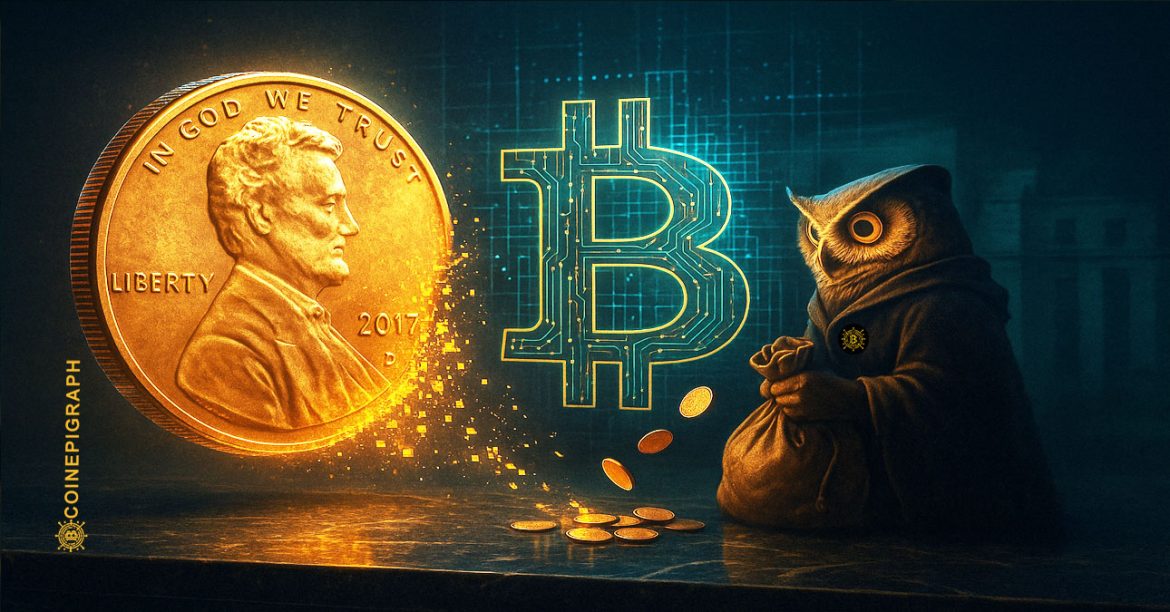By CoinEpigraph Editorial Desk | November 13, 2025
When the U.S. Mint confirmed the final production run of the one-cent coin, the announcement barely made headlines. A penny, after all, feels trivial — a copper-colored artifact tossed into drawers, car consoles, and donation jars. But the death of the penny is not trivial. It is symbolic. It is an obituary for the smallest unit of trust in the American monetary system.
CoinEpigraph Editorial Statement
-CoinEpigraph Editorial Desk
“The end of the U.S. penny isn’t just a monetary footnote — it’s a quiet admission that fiat inflation has hollowed out our smallest unit of value. It now costs more to mint a penny than a penny is worth. When a currency can no longer justify its own existence, savers must confront a hard truth: the system protects spending, not savings. Bitcoin flips that logic. It restores scarcity, rewards time, and gives savers back the one thing fiat keeps eroding — purchasing power. The last penny ever minted is more than a collectible. It’s a warning flare. And it shows, unmistakably, why the next generation of disciplined savers is migrating to Bitcoin and digital hard money.”
It now costs more than a penny to mint a penny.
That fact alone exposes a structural imbalance: the currency no longer sustains itself. The system has been debased so steadily, for so long, that the money used to manufacture a penny exceeds the value of the penny itself.
This is the quiet confession policymakers won’t publicly state:
Fiat currency is losing integrity at the atomic level.
And in that confession, savers — the backbone of any stable economy — receive a message the system never says aloud but broadcasts through its own inefficiencies: saving in dollars is not designed to reward you.
The Trajectory Is Clear
Across decades, the dollar’s purchasing power has eroded. A saver from 1980, storing wealth in dollars rather than assets, would have lost more than two-thirds of their purchasing power. A saver in 2025 faces the same mathematical trap: inflation outpaces deposits; yield rarely outruns debasement; and the “safe” instruments of old (savings accounts, CDs, bonds) provide returns that feel like token gestures against systemic decay.
The penny is simply the smallest casualty — the first unit to fail the cost-benefit test.
But it will not be the last.
Bitcoin Is What Happens When Savers Demand Refuge
Bitcoin did not emerge because technologists were bored. It emerged because the global monetary environment made two things painfully clear:
- Savers were being punished for saving.
- The financial system had no incentive to fix itself.
Bitcoin’s fixed supply, transparent issuance schedule, and algorithmic governance create a monetary asset that flips the saver-spender dynamic. It restores a fundamental principle lost in the fiat era:
Time should strengthen your savings, not weaken them.
Where the penny costs more to mint than it’s worth, Bitcoin costs more to counterfeit than the entire network can justify — because it cannot be counterfeited at all. Its security is derived from energy, mathematics, and consensus rather than political decree.
Why the Last Penny Matters More Than It Seems
The discontinuation of the U.S. penny is not just a “fun fact” for social media. It is a hinge moment — a small, almost ceremonial event signaling a larger truth:
The monetary system is quietly abandoning the symbols it can no longer defend.
A currency that cannot produce its own smallest unit without taking a loss is a currency drifting toward structural inefficiency.
Bitcoin is the antithesis of that drift.
It is built on provable scarcity, not inflation.
On decentralization, not political cycles.
On transparent rules, not reactive improvisation.
The last penny ever minted is, in many ways, the first domino in a much longer chain of monetary evolution — one that ends with digital hard money taking center stage.
A Warning Flare for Savers
This is the takeaway that matters:
The end of the penny is the beginning of a new savings philosophy.
For decades, households were told to let their savings “rest safely” in fiat. But as the purchasing power of a dollar weakens and its smallest denomination becomes economically unsustainable, savers are forced to confront a new reality:
Saving in Bitcoin is not speculation.
Saving in fiat is.
And the final batch of U.S. pennies is the historical artifact that proves it.
At Coinepigraph, we pride ourselves on delivering cryptocurrency news with the utmost journalistic integrity and professionalism. Our dedicated team is committed to providing accurate, insightful, and unbiased reporting to keep you informed in the ever-evolving crypto landscape. Stay tuned as we expand our coverage to include new sections and thought-provoking op-eds, ensuring Coinepigraph remains your trusted source for all things crypto. -Ian Mayzberg Editor-in-Chief
The team at CoinEpigraph.com is committed to independent analysis and a clear view of the evolving digital asset order.
To help sustain our work and editorial independence, we would appreciate your support of any amount of the tokens listed below. Support independent journalism:
BTC: 3NM7AAdxxaJ7jUhZ2nyfgcheWkrquvCzRm
SOL: HxeMhsyDvdv9dqEoBPpFtR46iVfbjrAicBDDjtEvJp7n
ETH: 0x3ab8bdce82439a73ca808a160ef94623275b5c0a
XRP: rLHzPsX6oXkzU2qL12kHCH8G8cnZv1rBJh TAG – 1068637374
SUI – 0xb21b61330caaa90dedc68b866c48abbf5c61b84644c45beea6a424b54f162d0c
and through our Support Page.
🔍 Disclaimer: CoinEpigraph is for entertainment and information, not investment advice. Markets are volatile — always conduct your own research.
COINEPIGRAPH does not offer investment advice. Always conduct thorough research before making any market decisions regarding cryptocurrency or other asset classes. Past performance is not a reliable indicator of future outcomes. All rights reserved ™ © 2024-2025.





